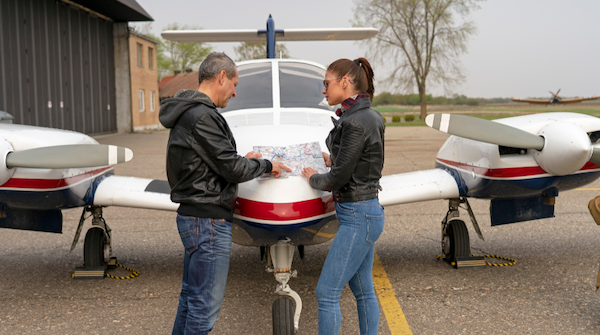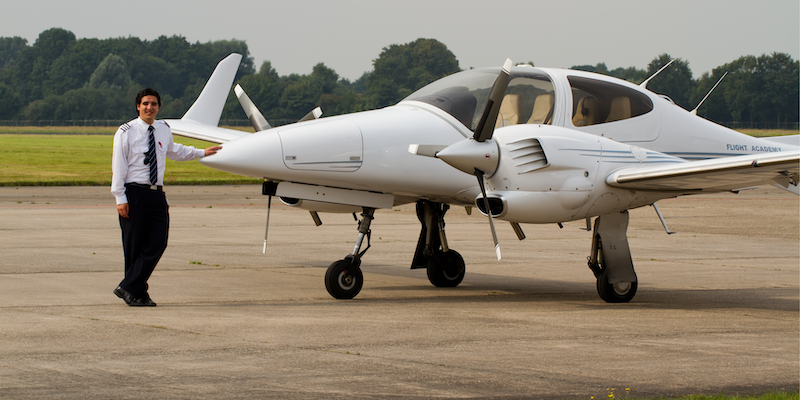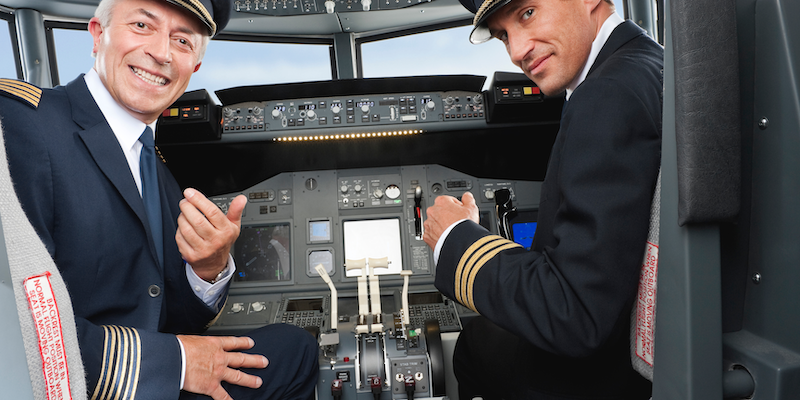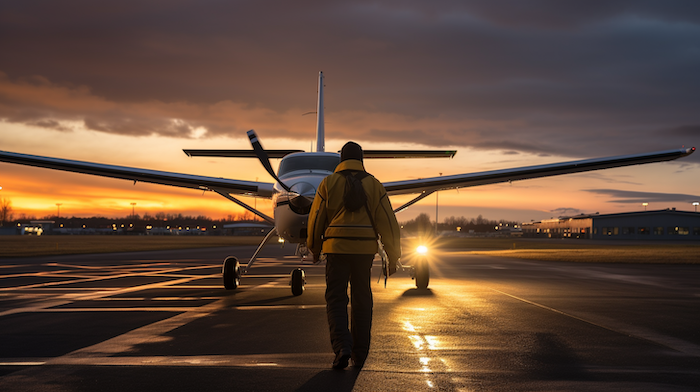Many aspiring pilots have this question in their minds as soon as they start researching their passion, as they encounter different timelines in their sources. But is there one definitive answer to this question?
On average, it takes about 5 years to become a pilot from zero, meaning that you have no prior flight experience. This is the number of years it takes to accumulate a total of 1500 flying hours, which makes you eligible to get your Airline Transport Pilot Licence (ATPL). This is a requirement for most major airlines.
However, for an aviation aspirant, the definition of becoming a pilot could vary depending on the milestone they aim for in their flying career, such as completing the flight training, earning the first dollar as a flight instructor or sitting in the right seat of an Airbus A380. Therefore, the average duration given above may not satisfy everyone.
So let’s explore the topic of how long it takes to become a pilot from the perspective of achieving each milestone on the journey of an aspirant to becoming a captain who would earn the highest salary in civil aviation. We will start from step zero in this blog post on how long it takes to become a pilot.
How long it takes to become a Private Pilot?

A Private Pilot is someone who has a licence (Private Pilot Licence or PPL) to fly without the assistance of another pilot. They are licenced to fly an aircraft for pleasure or personal business purposes. This is the first step for any aviation enthusiast, whether they want to just fly for fun or aspire to become the captain of the biggest jumbo jet.
A Private Pilot cannot fly any aircraft, they can only fly those that they have a rating for. For example, if a person wants to fly a single-engine plane like Cessna 172RG, they need to have a single-engine rating. If they want to fly a multi-engine plane like Cessna 310, they need to have a multi-engine rating, and so on.
To get these ratings, most civil aviation authorities require about 40 – 50 hours of total flying time, but usually a student takes more than the minimum required hours to get the certification. So on average, a student takes 3 to 6 months to get their PPL.
This depends on many factors, such as the student’s ability to learn a skill, the quality of instruction, the availability of flights for the student without waiting for schedules and external factors like weather and so on. Starting from here, we will keep track of the duration in terms of flying hours and time in months or years from the beginning.
Total numbers:
Flying hours: 45 hours minimum to 70 hours maximum
Duration from training start: 4 months to 8 months
How long does it take to become a Commercial Pilot?

A Commercial Pilot Licence (CPL) is required for anyone who wants to earn money for the services they provide by transporting someone or something from point A to point B in an aeroplane.
The licence specifies what kind of aeroplanes the pilot is allowed to fly for commercial purposes, such as Single-Engine or Multi-Engine, and what conditions they are allowed to fly in, such as Night Time (requires Night Rating) or Instrument Meteorological Conditions (requires Instrument Rating).
Depending on the Civil Aviation Authority of the country issuing the licence, the requirements may vary from 200 to 250 total flying hours, including categories of flying such as dual engine, solo, cross country (flying for about 300 Nautical Miles solo) and Pilot-in-Command time. But as mentioned for the Private Pilot Licence, these minimum required hours are only guidelines and usually students take longer to complete this phase.
The hours from the PPL will count towards this stage. So the duration will depend on the remaining hours and the pace of ground school. On average, the CPL phase of flight training takes between 8 to 16 months. In terms of flying hours, it could range from 200 to 300 hours in total, including those from the PPL.
And similar to a PPL, the duration the student takes to complete this phase depends on several factors, ranging from the student’s abilities to the flight school’s capacities. The duration also includes ground school and preparation for exams required by the country’s Civil Aviation Authority.
Total numbers:
Flying hours : 200 hours Minimum to 300 hours maximum
Duration from training start: 12 months to 24 months maximum
How long does it take to get a job after getting CPL?

At this point of an aviation aspirant’s journey, things may differ depending on the region and the opportunities available, but the journey will become more similar again once they land their first job in an airline. After they get their first job at a moderate-sized airline, the path will be more consistent. So, I will try to cover as many possible and popular paths and the different durations each one would take for an overall understanding.
Can a CPL holder get an airline job? How long does it take for a CPL holder to get a job?
A CPL holder may get a job right after training in certain scenarios, such as:
- If the training program was an Airline Integrated Program or a Cadet Pilot Program, where the individual completes the training by getting enrolled into a training program by an airline and gets a Letter of Intent of job offer or job interview by the airline upon successful completion of the training.
- If the country’s Civil Aviation Authority allows the airlines to hire a pilot with just a CPL for civil aviation, such as in the UK/Europe, India and so on.
The hiring in such cases will involve further training before the pilot is allowed to assume a Junior First Officer’s role, which will enable them to fly a plane under the command of a captain. These trainings include airline-specific operational trainings and a flight-related type rating (learning and certifying to fly a particular type of plane, e.g., Airbus A320), which will take anywhere between 4 to 6 months.
If the pilot has received the training from an institute in another country, they would need to convert their CPL licence as per the country of employment, which would take anywhere between 3 to 6 months.
Total numbers:
Flying hours: 300 hours minimum to 500 hours maximum
Duration from training start: 24 months to 36 months maximum
How long does it take to build hours for ATPL after CPL?
An Airline Transport Pilot Licence (ATPL) allows the pilot to assume the role of a captain of a multi-pilot aircraft. After a CPL, a student pilot would have to build up to a total of 1500 hours to become eligible for an ATPL.
Although the requirement of an ATPL is for those pilots who need to command a multi-pilot aircraft, most regional to major airlines in most countries will have an ATPL as a requirement to get even a first officer pilot job.
This is the longest and most time-consuming phase for most pilots and it is also sometimes the most underrated because it does not require as much money as one would spend while doing PPL or CPL.
A CPL holder can take many paths to reach the 1500-hour mark. Some ways to reach that number are:
- Becoming a flight instructor by getting a Flight Instructor Rating and teaching other students to reach their PPL or CPL
- Flying for minor flight operations like transporting people for recreational purposes like skydiving or other commercial activities
- Some pilots even manage to get into the corporate aviation at this stage and fly charter flights
- Some pilots purchase a used plane to build hours, while some share a rented plane with others on hour-building journeys.
All these paths take time and could range from the shortest duration of 18 months to 48 months or sometimes more than that.
Total numbers:
Flying hours: 1500 hours
Duration from training start: 42 months to 84 months maximum.
How long does it take for a First officer to become a captain?

When you get your first job in an Airline you are given the role of a First officer. In fact, even if you were a Captain in an Airline, when you switch to a new Airline you would be only assuming a First Officer role, which is why seniority is of a great importance in the field of Civil Aviation.
So assuming you were extremely lucky enough to get a First Officer role in your dream Airline company flying your dream plane, having an ATPL does not guarantee that you will become a captain right away. You also need to have enough turbine Pilot-in-Command (PIC) time, which is the time you fly as the captain or the person responsible for the aircraft. Different airlines may have different requirements for turbine PIC time, but it can range from 500 to 1000 hours or more
Additionally, you need to have enough seniority within your airline, which means that you have worked there for a long time and have a good reputation. Seniority is often based on the date you joined the airline, and it determines your priority for bidding for flights, schedules, bases and upgrades. Seniority can also be affected by the demand and supply of pilots in the industry, which can fluctuate depending on economic conditions, retirements, mergers, expansions, etc
Finally, you need to demonstrate your competency and performance as a pilot, which means that you have the skills, knowledge and attitude to fly safely and efficiently. You also need to pass the required type rating and checkride for the specific aircraft that you want to fly as a captain
Therefore, the time it takes to become a captain in civil aviation can vary widely depending on these factors. Some sources estimate that it can take anywhere from 3 to 10 years or more after obtaining your commercial pilot licence. However, this may change depending on your personal circumstances, career goals, and opportunities.
Total numbers:
Flying hours : 3000 flying hours +
Duration from training start: 5 years minimum to..well, it will take some time.
Conclusion
These numbers are as realistic as possible, but they are only meant to give you an idea of how long and challenging your journey will most likely be (5 years of a lifetime is no short time). They are not meant to provide a roadmap or plan to achieve those stages. We will soon publish an article on how to plan for success in your aviation career. Until then, please feel free to contact us using our contact form or the comments section below for any other questions.
You can read about how to become a pilot here

